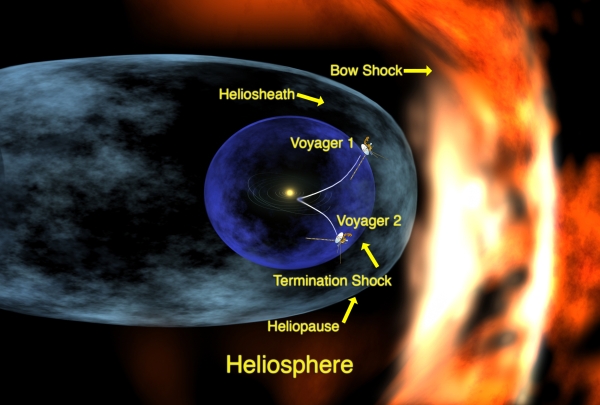[/caption]
The region of space within our Solar System is called interplanetary space, also known as interplanetary medium. Most people are so fascinated by the planets, Sun, and other celestial objects that they do not pay any attention to space. After all, there is nothing in outer space right? A common misconception is that outer space is a perfect vacuum, but there are actually particles in space including dust, cosmic rays, and burning plasma spread by solar winds. Particles in interplanetary space have a very low density, approximately 5 particles per cubic centimeter around Earth and the density decreases further from the Sun. The density of these particles is also affected by other factors including magnetic fields. The temperature of interplanetary medium is about 99,727°C.
Interplanetary space extends to the edge of the Solar System where it hits interstellar space and forms the heliosphere, which is a kind of magnetic bubble around our Solar System. The boundary between interplanetary space and interstellar space is known as the heliopause and is believed to be approximately 110 to 160 astronomical units (AU) from the Sun. The solar winds that blow from the Sun, and are part of the material in interplanetary space, flow all the way to the edge of the Solar System where they hit interstellar space. The magnetic particles in these solar winds interact with interstellar space and form the protective sphere.
The way that interplanetary space interacts with the planets depends on the nature of the planets’ magnetic fields. The Moon has no magnetic field, so the solar winds can bombard the satellite. Astronomers study rocks from Earth’s Moon to learn more about the effects of solar winds. So many particles have hit the Moon that it emits faint radiation. Some planets, including Earth, have their own magnetospheres where the planets’ magnetic fields override the Sun’s. The Earth’s magnetic field deflects dangerous cosmic rays that would otherwise damage or kill life on Earth. Material leaking from the solar winds is responsible for auroras in our atmosphere. The most famous aurora is the Aurora Borealis, which appears in the sky and is only visible in the Northern Hemisphere.
Interplanetary medium also causes a number of phenomena including the zodiacal light, which appear as a faint broad band of light only seen before sunrise or after sunset. This light, brightest near the horizon, occurs when light bounces off dust particles in the interstellar medium near Earth. In addition to interplanetary space, there is also interstellar space, which is the space in a galaxy in between stars.
Universe Today has a number of articles on space including the heliosphere and zodiacal light.
Check out these articles from NASA on the heliosphere and sunspots leaking plasma into interplanetary space.
Astronomy Cast has an episode on the heliosphere and interstellar medium.
References:
NASA: Heliosphere
NASA Voyager: Interstellar Mission
What’s It Like Where Voyager Is?

